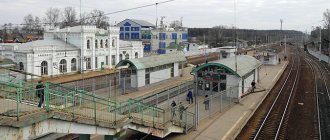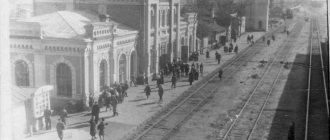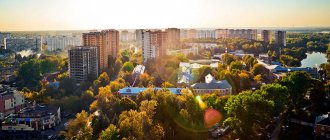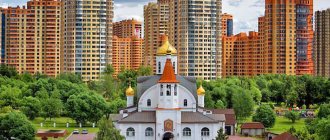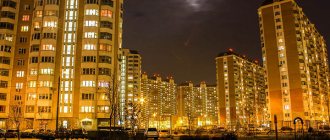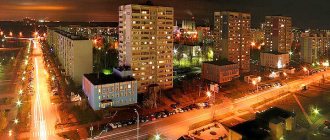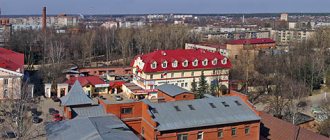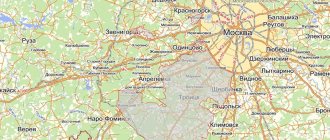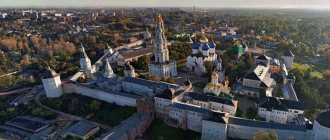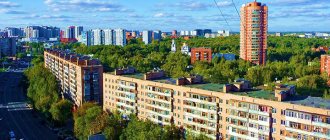For fans of Alexander Sergeevich - “our everything” in poetry, prose and Russian culture in general, let’s say right away: the city of Pushkino has nothing to do with him. Although a monument was erected here to Alexander Sergeevich (he sits on a bench with Krylov, as if talking), this is where all the similarities, random and non-random, end.
Let's look at what the city of Pushkino is like today, whether it is comfortable to live in it and what nuances need to be taken into account before buying real estate here.
Location Features
The city of Pushkino is located 12 km from the Moscow Ring Road along the Yaroslavskoye Highway (M8 Kholmogory). The most convenient way to get to it from Moscow is by high-speed train “Sputnik”, which runs from Yaroslavsky station. There are also “regular” train and bus services (from the VDNKh metro station).
Let us note some interesting facts about the city and surrounding area for those who are interested in real estate in Pushkino:
- The smallest street in the city is called Peschanaya, and there are only two houses on it;
- In the Pushkinsky district there is the village of Akulovo, which belongs not to the district, but to Moscow. It was built on the site of the village of the same name, flooded during the construction of the Uchinsky reservoir, and created for the needs of the Akulovsky hydraulic engineering unit;
- Together with the cities of Mytishchi, Korolev, Ivanteevka, Shchelkovo and Yubileiny, Pushkino forms the northeastern urban agglomeration, the largest in the Moscow region. The distance between these satellite cities is so small (2-4 km on average) that getting from one to another for work, shopping or entertainment is not difficult.
Map of Pushkino with streets
Currently, the structure of the city has retained its original structure. It consists of many towns and villages. Officially, it is divided into 12 districts, which can be seen on the map of Pushkino with streets.
The main transport artery connecting the city with Moscow is the highway passing through Pushkino from Yaroslavl. Large main streets are concentrated to the east of the railway:
- 50 years of Komsomol;
- Pisarevskaya;
- Oktyabrskaya;
- Moscow avenue;
- Akulovskoe highway.
The direction and intersection of highways allows you to see a map of Pushkino with streets and houses.
The railway station is located at the intersection of Moskovsky Prospekt and Vokzalnaya Street. Every day, many citizens travel by train to the capital and regional cities from this platform.
There is also a bus station, from which about 30 intercity routes leave in different directions. You can find the location of the bus station on the map of Pushkino with houses. There are a large number of Moscow dachas located in the city and its suburbs, so transport links are always very busy. The city is 1 hour away from Moscow by car.
Ecology
In the city of Pushkino, the Serebryanka River flows, there is a rowing base with a children's sports school, rentals and a place for kayaker competitions.
The townspeople also have the Ucha River and a spring with the beautiful name “Ivushka”: the water there is clean and, possibly, healing. Residents of Pushkino love Ivushka so much that they prefer spring water to tap water.
Behind the dam, Ucha forms the Uchinskoye Reservoir - a favorite vacation spot for the residents of Pushkin, popularly also called Tishkovo, named after the nearby village. The Uchinskoe reservoir is very clean - it supplies drinking water to the capital, ships do not sail through it, plus it has been given the status of a strictly protected zone.
Features of accommodation
In the city of Pushkino there are no industrial enterprises that emit harmful substances or do not comply with Sanpin standards. In the city there is a fur farm of the same name, where furs are bred. There is its own meat processing plant, beer (specializing in strong alcohol), and church utensils are produced in Sofrino.
In general, it so happened historically that weaving production was developed in Pushkino, and at the end of the 19th and beginning of the 20th centuries, summer residents chose Pushkin’s places and began to build country houses here, since the air was fresh, nature was beautiful in its pristine state, and transport links were well-functioning.
To this day, the city of Pushkino maintains a rare specialization for the Moscow region in the restoration and development of forestry (there is a seed fund, a forestry engineering laboratory, and a forestry research institute here). What could better testify to the natural resources of this area?
Story
There are several common versions of the origin of the name of the city of Pushkino. According to one of them, the name appeared in the second half of the 14th century, when the area along the Ucha River was owned by the boyar Grigory Aleksandrovich Morkhinin, nicknamed Pushka (d. 1380), the founder of the boyar family of the Pushkins (to which the poet Alexander Sergeevich Pushkin belonged). On September 3, 2010, a monument to Cannon was erected at the entrance to the city. There is a version related to the history of economic activity: near the village in the 18th century there was a state-owned factory for casting cannons.
Historian S. B. Veselovsky points out: “According to the acts it is known that at the end of the 15th century it belonged as “ancient” to the metropolitans of all Rus', and after the establishment of the patriarchate it became the patrimonial fiefdom of the patriarchs. How and when it came to the Metropolitan House is unknown. It is possible that it was acquired in the third quarter of the 14th century by Metropolitan Alexy directly from Gregory Pushka, but the possibility cannot be ruled out that it was alienated by one of the numerous descendants of Gregory Pushka in the 15th century.”
The first documentary mention of the village of Pushkino dates back to 1499 (“the scribal book of Prince V.I. Golenin for the metropolitan village of Pushkino, Moscow district”). The village was located on the oldest trade road in North-Eastern Rus' on the way to Pereslavl, Yaroslavl, Vologda, which contributed to the growth of its population and the high prosperity of its residents.
Also indicated as the village of Metropolitan in 1586 and in 1624-1625. Patriarch (in connection with the establishment of the Moscow Patriarchate in 1589) in the Bokhov camp of the Zamoskovsky half of the Moscow district of the Moscow province.
In the second half of the 18th century, the weaving industry began to develop: the production of woolen cloth, karazei, sashes, and silk scarves. In the first half of the 19th century, a copper plant and a wool weaving factory by K. F. Favor appeared in the village of Pushkino, equipped with one of the first mechanical looms in the Moscow district. By the end of the 19th century, the village had turned into a factory center.
In 1867, dacha construction began. In 1868, a zemstvo school was opened for children from 8 to 14 years old. In 1890, a library was opened with funds from E.I. Armand, to whom the wool weaving factory was transferred in 1853.
In 1880, a park was laid out not far from the station, which became a favorite vacation spot for Pushkin’s summer residents. In 1896, with funds from the Yakor insurance company, a summer theater was built in the park, but it burned down in the summer of 1993.
According to the directory of 1890, 1,164 people lived in the village of Pushkino, which was then part of the Mytishchi volost of the Moscow district of the Moscow province, and in 1899 there were already 1,560 people living. According to the boundaries of settlements of that time, the village of Pushkino was located 27 kilometers from Moscow and one and a half kilometers from the Pushkino station of the Moscow-Yaroslavl-Arkhangelsk Railway. From the station to the Pushkino station it is 30 kilometers. At that time, in Pushkino there was a police officer’s apartment, a zemstvo school, a school at the Armand factory and an almshouse.
In 1914, a postal and telegraph office was located in the village of Pushkino (headed by N.I. Lavrentyev). Several enterprises had a postal address at the Pushkino station in 1914: the Dmitriev brick factory in the village of Chapchikovo, the wool-spinning factory of the Kevorkov brothers in the village of Kurovo, the wool-spinning, weaving and finishing factory of the Lyzhin partnership in the village of Vanteyevka, the dyeing and finishing factory of the Veterme partnership, the finishing factory Kopylov and Ankudinov near the village of Nemichnov. There were two enterprises directly in the village of Pushkino:
- Cloth factory of the Cloth Manufactory Partnership, head N. S. Maslennikov (founded in 1883, in 1914 there were 257 employees, of which 257 were men);
- Mechanical weaving and dyeing and finishing factory E. Armand, head A. L. Kohl (founded in 1860, in 1914 1059 employees, of which 600 were men).
In 1914, in the village of Pushkino there was a pharmacy (pharmacist - V.F. Blumenthal), St. Andrew's Hospital at the Armand factory (doctors A.L. Kol and V.F. Burov), an almshouse for elderly factory workers of both sexes, established by a hereditary honorary citizen Evgeniy Ivanovich Armand (head E.I. Armand, 18 people in charge). At the Pushkino station there was a shelter of the Imperial Humane Society for convalescent children named after Albert and Anna Berenstam (headed by E. A. Alekseeva, 30 children were cared for).
In 1914, in Pushkino there were several primary educational institutions of different departments: Pushkinskoye I and Pushkinskoye II elementary zemstvo schools, the elementary Pushkin parochial school.
In 1915-1916, the architect V.I. Motylev, based on the drawings of the artist S.I. Vashkov, built the Church of the Savior of the Image Not Made by Hands.
Real estate
In addition to the countless number of holiday and cottage settlements, located mainly next to reservoirs, the housing market inside the city is also actively developing.
Apartments in new buildings in Pushkino are mainly built in the low-rise housing segment (townhouses and low-rise apartment buildings). There are few high-rise residential complexes in Pushkino. There are also practically no dilapidated buildings (not counting Akulovo), which means that residential buildings are being built on new construction sites, where utility networks, transport communications and infrastructure facilities are immediately thought out.
Attractions
On Akulova Gora there is a monument to Mayakovsky, who visited here and even wrote a poem about his stay in Pushkino on Akulova Gora.
In the village of Sofrino there is the famous Smolensk Church in the “Naryshkin Baroque” style, restored in the 1970s. Also noteworthy is the Church of the Savior of the Image Not Made by Hands in the neo-Russian style, built back in those years from reinforced concrete (!), according to the design of Vasnetsov’s student.
The city has preserved a small historical center, represented by an old water tower and 2-story houses built before the revolution. There is a special charm in these low-rise houses, wooden and stone, authentic buildings that coexist with new residential areas.
Did you find this article helpful? Please share it on social networks: Don't forget to bookmark the Nedvio website. We talk about construction, renovation, and country real estate in an interesting, useful and understandable way.
Pushkino city
On August 17, 1925, Pushkino received city status. It included a dacha village near the station and part of the village of Pushkino. On June 12, 1929, the city of Pushkino became a regional center. The district included two working villages - Ivanteevka and Krasnoarmeysk, the dacha village of Mamontovka, Sofrinskaya, Putilovskaya, Pushkinskaya volosts, several villages of Shchelkovskaya and Khotkovskaya volosts. In the same year, the first electric train ran from Moscow to Pushkino. A year later, electric trains reached Pravda station.
During the Great Patriotic War, over 36 thousand residents of the region were sent to the armed forces. On the territory of the Pushkinsky district, among others, the legendary separate special purpose motorized rifle brigade (OMSBON) was formed. In the fall of 1941, the front line passed 25 km from Pushkino and 15 km from Tishkovo. More than 15 thousand Pushkin residents took part in the construction of defensive structures on the near approaches to the capital in October-November.
In 1953, the city of Pushkino was classified as a city of regional subordination. Rapid construction began, Moskovsky Avenue was built up, and the Serebryanka microdistrict was built. In the 1970s - the Dzerzhinets microdistrict. At the turn of the 1970s and 1980s, the Armand microdistrict appeared, where many wooden houses in the village of Pushkino were replaced by nine-story buildings. Currently, the city is experiencing the so-called. spot development.
In 2002, the villages of Vetlechebnitsy and VNIILM were included in the city of Pushkino. In 2003, the dacha villages of Zavety Ilyich, Klyazma and Mamontovka, the villages of Mosproekt, the Sanatorium-Forest School and the Cardiological sanatorium, the villages of Zvyagino, Novaya Derevnya and Pushkino were included in the city of Pushkino.
